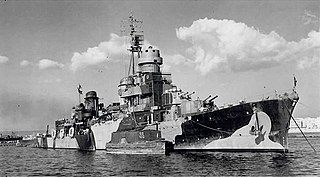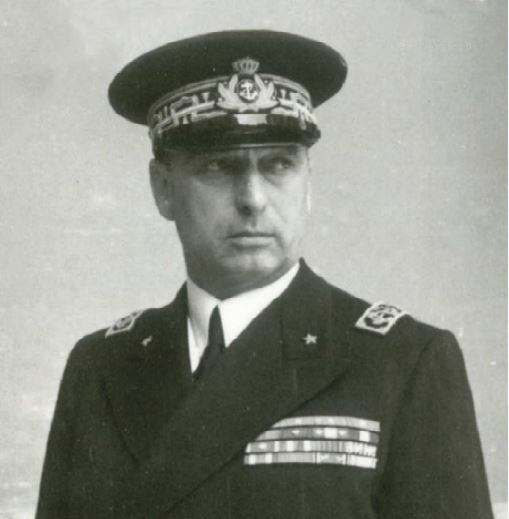
Operation Pedestal, known in Malta as Il-Konvoj ta' Santa Marija, was a British operation to carry supplies to the island of Malta in August 1942, during the Second World War.

The Regia Marina (RM) or Royal Italian Navy was the navy of the Kingdom of Italy from 1861 to 1946. In 1946, with the birth of the Italian Republic, the Regia Marina changed its name to Marina Militare.

Vittorio Veneto was the second member of the Littorio-class battleship that served in the Italian Regia Marina during World War II. The ship's keel was laid down in October 1934, launched in July 1937, and readied for service with the Italian fleet by August 1940. She was named after the Italian victory at Vittorio Veneto during World War I, and she had three sister ships: Littorio, Roma, and Impero, though only Littorio and Roma were completed during the war. She was armed with a main battery of nine 381-millimeter (15.0 in) guns in three triple turrets, and could steam at a speed of 30 knots.

The Battle of the Mediterranean was the name given to the naval campaign fought in the Mediterranean Sea during World War II, from 10 June 1940 to 2 May 1945.

Angelo Iachino was an Italian admiral during World War II.

The naval Battle of Cape Bon took place on December 13, 1941 during the Second World War, between two Italian light cruisers and an Allied destroyer flotilla off Cape Bon in Tunisia.

Gorizia was the third member of the Zara class of heavy cruisers to be built for the Italian Regia Marina in the 1930s. Named for the town of Gorizia, the ship was laid down at the OTO Livorno shipyard in March 1930, was launched in December that year and was commissioned into the fleet in December 1931. Armed with a main battery of eight 8-inch (200 mm) guns, she was nominally within the 10,000-long-ton (10,000 t) limit imposed by the Washington Naval Treaty, though in reality she significantly exceeded this figure.

Trieste was the second of two Trento-class heavy cruisers built for the Italian Regia Marina. The ship was laid down in June 1925, was launched in October 1926, and was commissioned in December 1928. Trieste was very lightly armored, with only a 70 mm (2.8 in) thick armored belt, though she possessed a high speed and heavy main battery of eight 203 mm (8 in) guns. Though nominally built under the restrictions of the Washington Naval Treaty, the two cruisers significantly exceeded the displacement limits imposed by the treaty. The ship spent the 1930s conducting training cruises in the Mediterranean Sea, participating in naval reviews held for foreign dignitaries, and serving as the flagship of the Cruiser Division. She also helped transport Italian volunteer troops that had been sent to Spain to fight in the Spanish Civil War return to Italy in 1938.

Trento was the first of two Trento-class cruisers; they were the first heavy cruisers built for the Italian Regia Marina. The ship was laid down in February 1925, launched in October 1927, and was commissioned in April 1929. Trento was very lightly armored, with only a 70 mm (2.8 in) thick armored belt, though she possessed a high speed and heavy main battery of eight 203 mm (8 in) guns. Though nominally built under the restrictions of the Washington Naval Treaty, the two cruisers significantly exceeded the displacement limits imposed by the treaty.

Bolzano was a unique heavy cruiser, sometimes considered to be a member of the Trento class, built for the Italian Regia Marina in the early 1930s, the last vessel of the type to be built by Italy. A modified version of the earlier Trento class, she had a heavier displacement, slightly shorter length, a newer model of 203-millimeter (8.0 in) gun, and a more powerful propulsion system, among other differences influenced by the Zara class that had followed the Trentos. Bolzano was built by the Gio. Ansaldo & C. between her keel laying in June 1930 and her commissioning in August 1933.

The Capitani Romani class was a class of light cruisers acting as flotilla leaders for the Regia Marina. They were built to outrun and outgun the large new French destroyers of the Le Fantasque and Mogador classes. Twelve hulls were ordered in late 1939, but only four were completed, just three of these before the Italian armistice in 1943. The ships were named after prominent ancient Romans.

The Battle of the Espero Convoy on 28 June 1940, was the first surface engagement between Italian and Allied warships of the Second World War. Three modern 36 kn Italian destroyers made a run from Taranto for Tobruk in Libya to transport Blackshirt anti-tank units, in case of an armoured attack from Egypt by the British.

The Gufo radar (Owl) was an Italian naval search radar developed during World War II by the Regio Istituto Elettrotecnico e delle Comunicazioni della Marina (RIEC). Also known as the EC-3 ter.

Leone Pancaldo was one of twelve Navigatori-class destroyers built for the Regia Marina between the late 1920s. Shortly after Italy's entry into World War II in June 1940, she was sunk by British torpedo bombers in Augusta, Sicily, but was later refloated and repaired. She was briefly used in fast troop transport missions to Tunisia until her second and final sinking by Allied aircraft in April 1943.

Luigi Biancheri was an Italian admiral during World War II.

Zeffiro was one of eight Turbine-class destroyer built for the Regia Marina during the 1920s. She was named after a westerly wind, Zeffiro, common in summer in the Mediterranean. The ship played a minor role in the Spanish Civil War of 1936–1937, supporting the Nationalists.

Scipione Africano was an Italian Capitani Romani-class light cruiser, which served in the Regia Marina during World War II. As she commissioned in the spring of 1943, the majority of her service took place on the side of the Allies - 146 wartime missions after the Armistice of Cassibile versus 15 before. She remained commissioned in the Italian navy after the war, until allocated to France as war reparations by the Paris Peace Treaties of 1947. Scipione Africano was decommissioned from the Marina Militare in August 1948 and subsequently commissioned into the Marine Nationale as Guichen, after briefly being known as S.7.

Pietro Barone was an Italian admiral during World War II. He was the naval commander of Sicily for most of the war.

The Italian torpedo boat Sagittario was a Spica-class torpedo boat built for the Regia Marina in 1936. During the Battle of the Mediterranean, in the Second World War, Sagittario was involved in several convoy missions, the most notable that known as the "Sagittario convoy", in the course of the Battle of Crete, for which her commander, Giuseppe Cigala Fulgosi, was awarded the Gold Medal of Military Valour. Sagittario survived the war. Re-classified as corvette in 1949, she was scrapped in 1964.
Barletta was an Italian cargo liner built during the 1930s and later became an auxiliary cruiser of the Regia Marina during World War II.



















